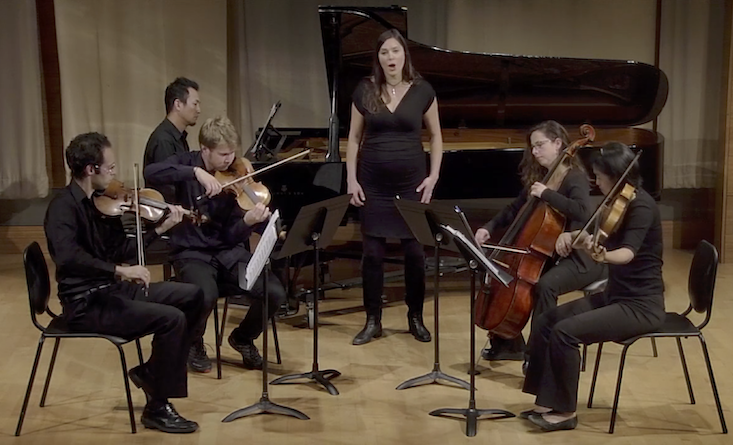When musicians have chemistry, we can feel it. There’s something special among them that’s missing when they perform alone. Anyone who’s heard a Mick Jagger solo album knows that’s the case. Clearly nature wants us to jam together and take flight out of our individual selves. The reward is transcendence, our bodies tell us so. What’s the secret of that chemistry?
It’s a question that one of the most refreshing neuroscientists who studies music has been probing lately. Refreshing because her lab is not only in academia but also on stage, where she performs as an opera singer and with chamber ensembles. Talking to Indre Viskontas is a treat because she animates her research as a scientist with her experiences as an artist. She breaks down the symphony of brain activity in the language of singing lessons and rehearsals.
In a recent interview, as Viskontas and I delve into the chemistry among performers, and the brain circuitry behind it, it becomes clear we’re talking about more than music. The qualities that make a great band, she is saying, represent a harmony in all of us, waiting for expression.

Somewhere along the way of growing up in Toronto, the daughter of Lithuanian parents, where music was the daily bread (her mother is a choral conductor), Viskontas must have discovered she was a natural explainer, and nourished that skill with singing. She earned a Ph.D. in cognitive neuroscience from the University of California, Los Angeles, in 2006. Today she’s the creative director of a small opera company in Pasadena, California; hosts a podcast, Cadence, on music and the mind; and just published a short book, How Music Can Make You Better. Her day job is as a professor of humanities and sciences at the San Francisco Conservatory of Music.
Viskontas tells me her inspiration to study the interplay among musicians arose out of her experiences. “Playing in ensembles is the whole reason I wanted to be a musician,” she says. “It’s just a magical feeling. It made me realize that whatever’s happening when we’re in sync, we’re exchanging a lot of intuitive information, and we use that to feed off each other. It has that intangibility, the stuff that happens below the level of consciousness that we’re all fascinated by. It’s also a different way to think about creativity. How is it that when musicians come together, they produce this wonderful product?”
Nobody at a concert remarks, This is totally stimulating my amygdala and insula!
When you’re in sync with somebody, are you activating parts of your brain that are dormant when you’re alone? “Yes, the evidence suggests that’s the case,” Viskontas says. “Here’s an analogy. If you forget somebody’s name, the more you think about it, the harder it is to access. The name isn’t dormant. Access to it is blocked because your conscious cognitive resources are going in a different direction. When you start thinking about something else, or leave a room, it pops into your mind. The same can be true for being alone. When you’re alone and intensely focused on something, you’ve got an inner critic going, you’re monitoring yourself. When you have to respond to somebody else, and allow yourself to hear other thoughts, you forget the inner critic. You hear other parts of your brain talking more loudly, more clearly. If you’re a solo performer, it’s really hard to get completely immersed in what you’re doing. When you have to respond to somebody else, it’s easier to forget your inner critic.”
In her early years as a singer, Viskontas says, she had a tough time silencing her inner critic. “One of the things we work on as sopranos is that when we have to sing a high note, we want to float it, we want it to be completely free, but also have a real arc in terms of dynamics,” she says. “There were times when I tried to do it in rehearsal and couldn’t find the freedom in my voice that I wanted. Then all of a sudden in performance I feel like I have way more stamina, way more flexibility, and I can express that phrase much more the way that I want to than I ever did in rehearsal.”
What’s going on in performance? “Allow me to deep-dive into the brain for a minute,” she says. “The left hemisphere, the part of your brain responsible for language comprehension, Wernicke’s area, is connected to the part responsible for speech production, Broca’s area, by a fiber tract called the arcuate fasciculus. When you’re trying to repeat a word someone else has said, trying to express yourself, you want the left part of your brain comprehending what’s coming in. Then you send that information to the production area, which figures out what you’re going to say, and sends the information to the motor regions, which activate the muscles and allow you to speak. For most people, the arcuate fasciculus on the right side is a lot thinner than it is on the left side. Except for singers. As singers develop their vocal ability, that fiber tract gets thicker. They have more connections. What’s happening is a singer is better able to hear something and produce it vocally, presumably using this right arcuate fasciculus. And that has a direct connection to how you are able to use your musculature.
“This is a long preamble to say that when you are performing with other people, you can tap into these connections, these pathways you’ve developed. Because there is an interplay between conscious control and more automatic responses in your brain and body, there are times when you can get in your own way. Your musculature can get in the way of the sound everybody wants to hear—one that’s easy and free and sounds like it’s coming from a soulful place, rather than you’re manipulating it.”
And how does she get to the soulful place? “I love working with string players,” she says. “For a long time, most of my training was with a pianist. When you’re performing with a piano, it feels percussive. There’s a beginning and an end that are abrupt. And that’s not good for breathing. You want breathing to be an organic process that opens and closes. I remember the first time I sang with a string orchestra. It completely relaxed my approach to breathing and made me a better singer. I was like, ‘Oh, that’s how I need to play my vocal cords. I can’t just play them like a piano, I need to play them like a violin, where I’m coaxing, rather than pushing, the sound out of them.’
“In terms of biology, you make a sound by bringing your two vocal cords together and apart. If you don’t have tension, your vocal cords come together in ways that are supple and gentle. As a singer, you want them to kiss softly. The sound comes from the breath. When I sing with a string orchestra, we all have to breathe together. That breath becomes the music.”
At the San Francisco Conservatory of Music, Viskontas is conducting a series of experiments called The Ensemble Project to learn how musicians can play the most evocative and moving music together. In a recent experiment, followed by an article in the journal, Behavioral Sciences, Viskontas, Matthew Slayton, and Adam S. Bristol varied the conditions in which six musicians played a chamber piece.1 The conditions include seeing one another but avoiding direct gazes, playing with no gestures and strictly by tempo markings, and not seeing one another at all. When the musicians see each other but avoid direct gazes, “they feel less connected and the performance is less coordinated.” When they play with technical strictures, they also feel the music suffers. When they can’t see each other at all, they rely more on auditory cues and are less distracted by their context, “making the performance feel more intimate.”

Viskontas’ Ensemble Project is informed by a satchel of studies that journey into the brain to see what neural networks are and aren’t firing when performers are in the flow of music. In 2012, Charles Limb, a neuroscientist and surgeon, now at the University of California, San Francisco, led a study that asked professional jazz musicians to jam on a special keyboard in a functional MRI scanner.2 When the musicians were in the groove, improvising, their medial prefrontal cortex, responsible for fashioning a sense of self and internal motivation, was alight. Meanwhile, their lateral orbitofrontal cortex and dorsolateral prefrontal cortex, which monitor, evaluate, and correct goal-directed behaviors, deactivated. Their inner critics were chilling, allowing “spontaneous unplanned associations, and sudden insights or realizations” to flourish. When the jazz players injected emotion into the notes, they stirred connections among the limbic and paralimbic areas, such as the amygdala and insula. Limb and his fellow researchers conclude that performing with emotion stirs a bounty of neural connections that allow musicians to slip into flow states, where inhibitions give way to pleasure and freedom, keys of creativity.3
When I sing with an orchestra, we all have to breathe together. That breath is the music.
Germane to Viskontas’ work, neuroscientists have shown that music releases the social-bonding chemicals in our brains and bodies. Playing and hearing music, one 2014 study relates4, engages the “endogenous opioid system,” releasing a cascade of neurohormones—oxytocin and vasopressin, dopamine and serotonin—bequeathed to us by nature to draw us into protective enclaves, fall in love, and keep the genes going. When musicians feel connected, they communicate better and read one another’s gestures more clearly. Good communication allows them to “respond to performance errors or perturbations flexibly, by expanding their cognitive effort and moving away from a rote performance,” Viskontas, Slayton, and Bristol write. Poor coordination, meanwhile, can arouse musicians’ lateral prefrontal cortex regions to impose control and ground them before they can take flight.
Slayton, a classical music composer who recently graduated from the San Francisco Conservatory of Music, tells me about one of the most eye-opening studies behind his and Viskontas’ recent paper.5
The study separates individuals into high and low creative groups. (Creativity is measured by participants’ ideas for alternative uses of everyday objects.) Each of the pairs is given the same hypothetical problem to solve. The surprising result is that pairs of less-creative individuals perform as well as pairs of high-creative individuals. Being in sync shows up in their brain scans, which reveal increased activity in prefrontal regions correlated with cooperative behavior and group creative performance. The study underscores what good chemistry among musicians means. Individual band members may not be the best musicians, compared to others, and may not be the best musicians when they perform alone. But when they come together, they are, well, the Beatles.
“The more tightly the social parts of our brain are connected, the more possible it is that performance will be more moving, more expressive,” Slayton says. “Brains are social, people are social, and when they’re connected, that has the best effect for creativity.” Slayton offers that understanding the social nature of brains spurred him to reflect on his own music. “To be honest, I used to be more interested in heady concerns that only other composers would care about,” he says. “Many people use music for expression and communication of something personal, and I never related to that. But the more I’ve learned about how brains connect, about emotional synchrony, I’ve been thinking more about how a listener will respond, about the emotional impact music will have on the listener.”
Having natural chemistry with others is wonderful, Viskontas says. But it doesn’t have to follow the romantic script of being something you either have or don’t have with them. It can be developed in rehearsal.
“If you feel in sync with the rest of the group, that’s great; you don’t have to worry about whether the next time you demonstrate a downbeat, they’re going to pick it up,” Viskontas says. “But sometimes it just takes a few rehearsals for you to say, ‘Oh, I get it, when you’re setting the pulse, it’s in the way your chest is moving.’ So you do it again until you agree on what the pulse is in this particular measure. Now you’re starting to know the other person better, you’re starting to read their gestural language better. Conductors often practice in front of a video camera or mirror. They look at themselves and ask, ‘Was it clear what I was trying to show? Are my body gestures indicating what it is that I think they are?’ It’s like practice in any other athletic or physical endeavor.”
Viskontas says the brain chemistry among musicians is also what gets listeners high. “The way we interact with music is very much in line with developing empathy, and how we put ourselves in the shoes of the musician,” she explains. “Our brains mirror what we’re seeing. So when we’re in sync, many of the rhythms of our brains and bodies entrain—heart and respiration rates, certain brain wave patterns. When you’re moved by music, we see levels of the attachment-hormone oxytocin increase. People who sniff oxytocin before they play together are more in sync rhythmically. For all of us, these neurochemicals make us more attuned to the signals we use to understand each other’s behavior.”
I say to Viskontas that her research into the neurobiology of music is great for science journals. But what’s it done for her as a singer? She laughs, and answers that it’s helped her lure audiences into her vocal lair.
“My teacher used to say, ‘Indre, all the notes leading up to the high note are important. The high note doesn’t matter.’ I would say that’s nuts. They’re paying me for the high note. If I screw up the high note, everyone will remember. Then I read research about how the caudate nucleus, the ‘wanting’ part of your brain, tracks. There’s more dopamine in that area as you’re anticipating the climax of a musical piece. Once you get to the climax, you get a boost of dopamine in the nucleus accumbens, which is the ‘liking’ part of the brain. When I read that, I learned why all the notes leading up to the high note matter more.”
When you have to respond to somebody else, it’s easier to forget your inner critic.
She continues. “If you don’t take the audience on a journey, showing them that just around the corner is this awesome thing, they won’t enjoy it as much. I used to think that I just need to feel the emotion and the audience will get it. Then I realized, No, I need to be a magician. If I went on stage and there was silence before I started to sing, I would think, ‘I need to get going, the audience is getting bored!’ Now I realize the longer I can extend the silence, the better. I just stand up there and luxuriate in the tension that I’m creating by not singing. So that’s what I got from neuroscience, the insight that I need to get the audience’s brain in the right mode to enjoy what I’m about to do.”
Viskontas and I agree that reducing music to neurobiological activity leaves us feeling unsatisfied. Nobody at an amazing concert remarks, This is totally stimulating my limbic and paralimbic areas, especially the amygdala and insula! The language of neuroscience undermines the richness of lived experience.
But what’s remarkable about hearing from the artist about biology is the reminder of what our brains are capable of, maybe something we’ve forgotten, or never known. When we’re in sync with others, we silence the critic in our brains, allow emotions to stir new neural connections, and become “more aware of our sensory environment,” Viskontas says. This mental state allows musicians to tap the flow of their fellow performers and create sounds they couldn’t shape alone. It’s a harmony that resounds beyond the concert hall.
“The pleasure and meaning we get from playing in sync underscores how rewarding it is when we feel connected to others,” Viskontas says. “There’s no a priori reason why this should be pleasurable—the way other drives like hunger and thirst yield pleasure because they keep us alive. But it’s more interesting than that. It gives us the suggestion that there is more to life than just ourselves. The pain of social isolation shares neural underpinnings with physical pain. But the sense of belonging is comforting. It’s akin to a religious experience, where you feel the ecstasy of finding meaning in connecting with what you believe is a higher power.”
For many of us, music is that higher power. “It allows us to communicate with each other in ways that transcend language, in ways that transcend these other kind of barriers we have,” Viskontas says. “It allows us to understand each other in ways that no other medium does.”
Kevin Berger is the editor of Nautilus.
Footnotes
1. Matthew Slayton, Adam S. Bristol, and Indre V. Viskontas, Factors affecting group creativity: lessons from musical ensembles, Behavioral Sciences 27 (2018)
2. Mónica López-González, Ph.D. and Charles J. Limb, M.D., Musical Creativity and the Brain, Cerebrum Jan-Feb (2012)
3. Malinda J. McPherson,a, Frederick S. Barrett, Monica Lopez-Gonzalez, Patpong Jiradejvong, and Charles J. Limb, Emotional Intent Modulates The Neural Substrates Of Creativity: An fMRI Study of Emotionally Targeted Improvisation in Jazz Musicians, Scientific Reports (2016)
4. Bronwyn Tarr, Jacques Launay, and Robin I. M. Dunbar, Music and social bonding: “self-other” merging and neurohormonal mechanisms, Frontiers in Psychology 5: 1096 (2014).
5. Xue H, Lu K, and Hao N, Cooperation makes two less-creative individuals turn into a highly-creative pair, Neuroimage, May 15 (2018)
Lead image: Monkey Business Images / Shutterstock


























